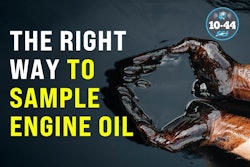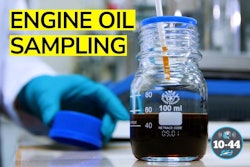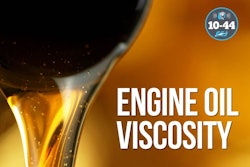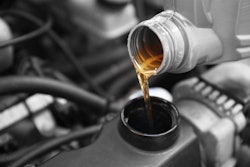Air goes into the engine from the front and goes out through the exhaust, but what happens to that air from point A to point B – and how smoothly it can get there – plays a massive role in operating costs.
Contents of this video
00:00 10-44 intro
00:27 Engine airflow
00:56 Diesel particulate filter (DPF) ash clogs
02:46 Ultra-low ash engine oil
06:14 Benefits of reducing DPF ash
Speaker 1:
CCJs 10 44 is brought to you by Chevron Delo, heavy duty diesel engine oil. Now there's even more reasons to choose Delo, how your engine's ability to breathe affects its overall efficiency. You're watching CCJs 10 44, a weekly episode that brings you the latest trucking industry news and updates from the editors of CCJ. Don't forget to subscribe and hit the bell for notifications so you'll never miss an installment of 10 44. Hey everybody, welcome back. I'm Jason Cannon and my co-host is Matt Cole. Air goes into the engine from the front and it goes out through the exhaust. But what happens to that air from point A two point B and how smoothly it can get there plays a massive role in your operating costs.
Speaker 2:
An engine with poor airflow isn't going to hit fuel economy benchmarks, and if that isn't addressed, MPG numbers are only going down. One of the primary gatekeepers of airflow is the diesel particulate filter, how clean or how clogged it is.
Speaker 3:
We're talking about the engine ability to breathe. I have a little fun thing I do once in a while. Beverly Hills Cop and the original one, the character sneaks across the street and puts a banana in the tailpipe and impedes the engine. So guys he doesn't want following could follow 'em. That's exactly what Ash ultimately does, is it builds and builds and builds until it chokes out. For example, you're running down the road and they choke you out. What happens? Well, you lose performance. How that shows up in trucks, for example, over the road trucks is that they lose fuel economy. Now we've got some marketing materials out there where when we do a value model and we look at like, what does that mean, like two or $3,000 a year per truck in fuel because it can't breathe. Just exactly like what I said. If you're choking somebody out, if it can't breathe, it loses performance and that shows up as fuel economy.
Speaker 1:
We're just a little more than two years from a new engine oil category that will require oil manufacturers reduce sulfated ash to 0.9% down from a full percent, but there's already an engine oil on the market that's doing significantly better than half that. So what is it? Gene tells us after a word from 10 44 sponsor Chevron lubricants.
Speaker 4:
We serve customers from Birmingham, Alabama to the Gulf Coast, so our people and our trucks are booked solid all day. There is no slack in our schedules. These trucks can't break breakdown. I choose an engine oil that takes care of the number one issue with our engines emissions, so we don't have to worry about DPF clogging. I choose the engine oil that keeps our trucks hauling. I choose DELO 600 A DF.
Speaker 3:
Before all these DPFs showed up, we had 1.5, 1.4% sulfated ash, low ash, which is where most everybody is right now, is 1% sulfated ash. That is an API specification you can't have anymore. That's things like zinc and magnesium and calcium, other metals that are in there. Okay, so that's low ash. I'm going to 0.9. Okay, it's less, but it's not that much less. So I'm going to say that 0.9 is still going to carry the name of low ash. This is me talking, but for sure, 0.4, which is what double 600 is, is ultra low ash, and that's what we have to differentiate. Everybody thinks when we start talking about ash, I already have low, well, there's a word bigger than or less, which is ultra ultralow ash. We use what we call a chemical box to kind of talk this thing through, and we look at phosphorus and sulfur and volatility and sulfated ash and the PC 11, which is the CK four FA four spec that we have right now today is going to be upgraded to PC 12.
Now that'll probably be called KL will be the next litter in the alphabet, probably be called CL four, but right now it's just called PC 12. But what they're doing is they're lowering the phosphorus, they're lowering the sulfur, the volatility stays the same, and the sulfated ash goes down to 0.9. We probably mostly want to talk about the sulfated ash because ASH is what ultimately kills A DPF, so is fuel related, and it comes and goes through regeneration, builds some back pressure in the system, regen cycles kicks in, and then it burns that out and it goes on and on and on and on. So the soots fuel related, and there's two sides of the equation. There's the soot side and the ash side, and so on the soot side, that's fuel related and it goes away during regen, as I just said, but the ash, it builds up over time, and ultimately the ash is what kills A DPF.
The ash builds and builds and builds until there's really not enough room for regen anymore, and the fuel economy tanks, there's all kinds of things that go, so we're really looking at the ash content. Now. The current spec is 1%, and we've been that way for quite a while, since about 2007, 2006. You can be lower than that, but at the time it wasn't commercialized. And the demo 600, that's a little bit different here that we're talking about is 0.4. Now, PC 12 is looking to be at 0.9, so there's still a significant difference. The dental 600 relative to ash and other things is way ahead of the game here. We're past PC 12. I kind of like to joke around and say, Hey, we might even pass 13 or 14 that are way off in the future here, relative dash, and then of course phosphorus. We don't have any phosphorus. They are going to lower the phosphorus, but our formulation doesn't have any phosphorus. So this chemical box is getting, the ideal thing is to get smaller inside this chemical box, and we're very small. We're way smaller than the new category is suggesting, and by the way, that is not a for sure deal. They haven't completely voted on it. It's still tentative, it hasn't been rubber stamp.
Speaker 2:
Reduction of ash in the DPF is obviously good for the DPF and airflow through it, but even if you trade your trucks well before you need to replace or clean A DPF gene says there are plenty of benefits to be had by reducing ash content.
Speaker 3:
If you have less ash, then there's more room for the soot to come and go through regeneration. Ultimately, the DPF lasts longer as well, but during that period of time, you have fuel economy retention, which is you save fuel because the engine can breathe better. There's three buckets that save money. When we do a value model, we look at, okay, what is the DPF savings in your example? You said the guy doesn't change his dpf, but then there's drain interval, okay, and then there's fuel economy. We look at all three of those. We actually create a number in all three categories and then totalize it. But some people, like you just said, they said, no, I don't want to listen to that. I'm only going to listen to bucket two or three or bucket one or whatever. But no matter which bucket you look at it more than pays for the oil, and when you look at all three of 'em, it's a substantial savings. When we plug it in a value model, I've never had a negative. What I mean by that is that when we look at like, okay, here's your cost for this. Here's your cost for that. Here's your drain interval. Here's how long the DPF goes. Here's what you do. You clean it, you replace it, whatever. When you put all that in the mix and do a calculator, they always come out positive.
Speaker 1:
That's it for this week's 10 44. You can read more on ccj digital.com. While you're there, sign up for our newsletter and stay up to date on the latest in trucking industry news and trends. If you have any questions or feedback, please let us know in the comments below. Don't forget to subscribe and hit the bell for notifications so you can catch us again next week.











